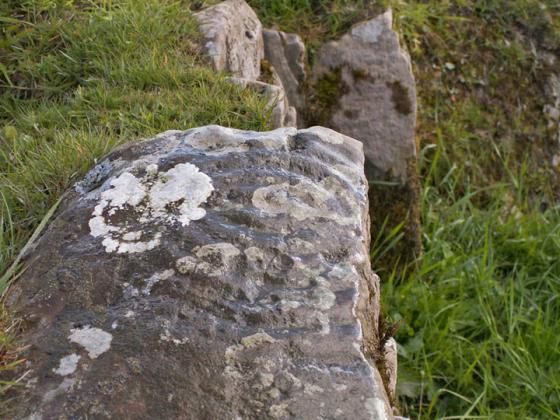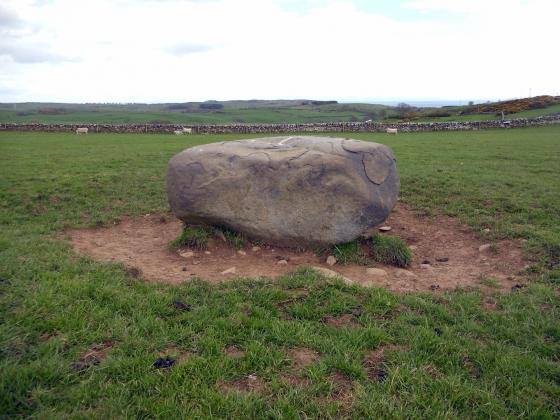
A possible crannog c. 45 yards W of Ash Island in Carlingwark Loch viewed from NE.

A possible crannog c. 45 yards W of Ash Island in Carlingwark Loch viewed from NE.

Ash Island on Carlingwark Loch viewed from NE. A crannog was constructed on the island.

Ash Island and adjacent man-made island on Carlingwark Loch viewed from NE.

Visited 28.10.18
There are 2 probable crannogs in the SE corner of Carlingwark Loch, on the S edge of Castle Douglas in Dumfries and Galloway. According to Canmore ID 64674 “Two artificial islands were found when the loch was drained in 1765. At the same time two dugout canoes, a dam, to maintain the level of the water in the loch, and a planking floor were found.” OSA 1794 (T Halliday). A later report states that “there were four fortified islands, two of them artificially constructed of oak piles.” (J Stuart 1875).
Fir Island, a natural island in the SE corner of Carlingwark Loch, is likely to be one of the fortified islands. Ash Island, an artificial island c. 55 yards N of Fir Island, is another likely candidate. A crannog was constructed on the island, probably connected to Fir Island by a causeway. Ash Island is subrectangular, measuring c. 20 yards E-W and 10 yards transversely, with a central clump of mature trees. An unnamed subcircular artifical island, occupied by a mature tree, lies c. 45 yards WNW of Ash Island. It measures c. 10 yards in diameter and may have been connected to Ash Island by a causeway. It could have been one of the man-made fortified islands on Carlingwark Loch.
The loch contains six islands, one of which – known as the Ash Island – is evidently artificial. It has been formed, as a writer in the Statistical Account says, “by driving strong piles of wood into the moss or marl, on which were placed large frames of black oak.” These were discovered in 1765, when the loch was drained for the purpose of procuring marl.
Tradition says that in early days it contained two large islands – one at the north end, which is now a peninsula, but still retaining the name of “The Isle,” while the other, near to the south end, is called “The Fir Island,” and appears to have been rendered famous in history as the spot where Edward I., on penetrating into Galloway in the year 1300, encamped, using the island as a place for shoeing his cavalry. To strengthen this supposition, we may state that near to this place many horse-shoes, of a form different to those now in use, have been found sunk deep in the mud [...]
The loch was formerly much larger than it is at present; and tradition narrates that there was a town which sunk, or was drowned, in its waters, and that there were two churches or chapels, one upon each of the large islands. The submersion of the town is in all likelihood a myth, although the truth of the story is believed by many of the old inhabitants; and we have heard that occasionally, during very dry seasons – that of 1826 being specially referred to – the roofs of houses have been discerned submerged in the loch. [...]
You can also read about the ancient Three Thorns of Carlingwark which grew near the loch. “From time immemorial they were used as a trysting-place by the lairds and yeomen throughout Galloway; and in history we find repeated mention of them made in connection with stirring events.”
From ‘Rambles in Galloway‘ by Malcolm McLachlan Harper (1876)
From volume 7 of the Proceedings of the Society of Antiquaries of Scotland (1870).
December 1866. The Donations to the Library and Museum were as follows, and thanks were voted to the Donors:-
1. By Samuel Gordon Esq. and J T Blackley, Esq, Castle-Douglas, Kirkcudbrightshire.
Large Caldron, formed of very thin plates of yellow bronze, the bottom being formed of one large sheet, and the sides of various smaller portions, all riveted together. It is patched in various places with additional bronze plates of various sizes riveted on. The caldron measures 26 inches in diameter across the mouth, the sides being straight, but bulging out to the extent of 1 inch above the rounded and flattened bottom. Part of the circumference of the mouth, where the handle had been attached, has been torn away.
The caldron was dredged up by the donors from Carlingwark Loch, Kirkcudbright, and contained
an adze, 7 inches in length, 2 inches across the face (Plate 1 fig. 1);
three axe-heads, measuring from 4 1/2 to 5 1/2 inches in length, and 2 to 2 1/2 inches across the face (figs. 2, 3, 4) – each of these tools have small projections of the metal on each side of the half-hole;
four small picks or hammers, with narrow extremities, from 6 to 7 1/4 inches in length (fig. 5) and apparently a broken half of another hammer-head, 4 inches in length;hammer-head with flattened ends (fig. 6);
portion of a small saw, 6 1/2 inches, with blade 1 inch in breadth – a portion of the wooden handle remains riveted to the blade (fig. 7);
portions of a fine cut saw, 2 1/2 inches in length and 1 1/2 inch in breadth;
nine portions of double-edged blades, with pointed extremities resembling sword points, from 2 1/2 to 6 inches in length, and from 1 1/2 to 2 inches in breadth;
nails of various lengths, one with a large head, with a cross marked on each side (fig. 8);
small slender chisel, 5 inches in length, 3/4 of an inch across the face; portion of another chisel; three punches, 4 3/4 to 5 3/8 inches in length (fig. 9);
four split bats with eyes (figs. 10 and 11);
two large holdfasts; six hooks, varying in size from 2 1/2 inches to 5 inches in length (fig. 12);
iron buckle (fig. 13);
two handles with loops, apparently the handles of a bucket, one rudely ornamented with punched parallel lines (figs. 14, 15, 16);
wooden handle (fig. 17);
an iron implement (fig. 18);
iron tripod or ring, with three feet, apparently for supporting a pot (fig. 19);
and an iron frame, with numerous bars, and having two feet, the other two apparently awanting, the whole resembling a rude gridiron; five pieces of iron handles, one measuring 5 3/4 inches in length by 1/4 of an inch in breadth, has a loop at each extremity (fig. 20);
snaffle horse-bit, with check-ring 3 inches in diameter (fig. 21);
file, 9 3/4 inches in length and 1 inch in breadth; various scraps of iron plates; portions of iron hoops or bands perforated with holes.
That’s a lot of stuff. I started to regret typing the list. There are a few more things listed but I got the impression they were other stuff being donated by the two men mentioned, rather than stuff found in the caudron. There’s a photo of the cauldron here on the NMS database, along with all its miscellaneous contents.
Though crannogs are believed to be Iron Age a bronze sword was found in Carlingwark Loch (and a flint arrowhead, knife and scraper found at NX772613).
The small crannog near Ash Island was discovered during limited drainage in 1765. Fir Island is not artificial but is reached over a prehistoric causeway.
A large hoard of weapons has been found in the loch.








































































